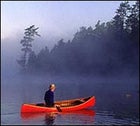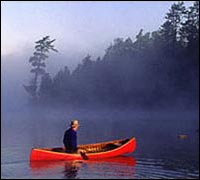As you float serenely along any of the countless placid waterways coiled throughout Ontario’s Temagami region, there’s a question you can’t help but ponder: Why on earth has our outdoor culture so giddily embraced the extreme? There is, after all, such a venerable tradition of being easy in the outdoors. “We do not go to the green woods and crystal waters to rough it,” wrote George Washington Sears back in 1884, in his timeless book Woodcraft. “We go to smooth it.”

Five score years and change later, truer words have yet to be spoken. And there’s still no better means for soothing the spirit than a canoe. At least if you have any interest in, say, an uninterrupted string of lazy days on perfect water in a beautiful place, with high drama provided only by dawn and sunsets and maybe the occasional heron sighting. There’s no need for paranoiac weight-paring. Or worrying of any kind. You’re self-sufficient, but not self-supporting. You can bring whatever you want. It’ll float. You’ll float. The world will slip away.
Of course, for this last you must pick the right spot. A body of water that seems to exist solely for contemplative paddling. A bastion of serenity on our increasingly hyperactive continent. A place like Temagami, where a dozen big lakes, including the area’s namesake, are interconnected with a thousand small ones in the woods of Canada’s Near North, about five hours or so from Toronto.
The Temagami region, in my opinion, is the most perfect spot remaining in North America for recreating, in the old-fashioned sense of the word. It’s a place to be rejuvenated, made anew. No charter fly-in is necessary, and no strict scheduling either. You put in when you want and take out the same way. In between, you paddle slowly through old-fashioned beaver, bear, and moose country, on the line where hardwoods begin giving way to the boreal forest of the Far North. The hills are ancient and well worn, an occasional northwest-to-southeast ridge showing which way the ice cap withdrew. The highest point in Ontario, 2,275-foot Ishpatina Ridge, is close by. Paddling farther, you can easily push on to real wilderness—or, as the Canadians say, deep bush. Extreme country, indeed. But have no doubts: If your craft is well stocked and your date book is empty, Mr. Sears would certainly approve.
The journey begins at one of the most evocatively named lakes in North America: Temagami (“tuh-MAHG-uh-mee”), the perfect eponym for every child’s Platonic ideal of summer camp. About 250 miles north of Toronto, up on the 3.5-billion-year-old Precambrian Shield, Temagami is a big lake, with 300 miles of shoreline, 50,000 surface acres, 1,200 islands, and disconcertingly at first, hundreds of summer cottages.
The cottages are the giveaway: The main body of Temagami is not wilderness. There’s electricity here, and ski boats, and floatplanes. But Temagami is also a lake with long arms—seven of them—and each limb has an outlet that leads to another significantly less developed lake. And another after that, and another, and another, and so on, ditto, into peace and quiet and solitude, until empty, primitive campsites open up among towering red and white pines, or beneath granite cliffs, beside the most amazing water you’ll ever be privileged to immerse yourself in.
Excuse the hyperbole, but eastern American forest lakes are usually tannin-dark, and these are not. These are sunlit, and of a stunning clarity. They vary subtly in tint—Temagami itself is the deepest blue, the others flashing subliminal hints of green, red, even yellow—but they are always startlingly transparent, drawing the eye, not to mention the unclothed body, into seductive depths.
When I was a kid in Texas, one of my aunts came back from a Canadian vacation babbling about the lake swimming in that mysterious foreign nation. It was like diving into champagne, she said. That descriptive phrase leaped out of my memory the first time I slipped over the side of my canoe and into Lake Temagami’s blue, blue waters. The coolness closed around me. Bubbles broke and rippled across the surface. I shut my eyes, sipped, and decided yes, a very fine vintage.
The next lakes over from Temagami have equally marvelous names: Lady Evelyn, Anima Nipissing, Wanapitei, Obabika. Each leads on to several others. The Sturgeon, Montreal, and Temagami Rivers are occasional linkages, but more often you use a smaller lake, with a portage on each end, to connect your dots. The conventional trips are loops. For example, Lake Temagami to Red Cedar, Cross, and Jumping Caribou Lakes, returning through Wasaksina to Temagami’s Shiningwood Bay. That particular loop covers 60-plus miles. It’ll take five days if you push, more if you’re reflective. You get a look at and a dip (paddle, fishing line, full body) in 14 lakes large enough to be named, plus a lovely stretch of the Temagami River, with a couple of moderate rapids. It’s a good route for intermediates, or for novices if they portage the rapids. The longest of the 21 portages is three-quarters of a mile, the shortest a 25-yard lift-over. Put-in and take-out are at the end of the Lake Temagami access road, which saves 11 not very interesting paddling miles down the northeast arm of Lake Temagami (and avoids the bustle of the lake’s main body).
My wife and I did that loop on our very first trip to Temagami. The various lakes have since become a blur as far as names are concerned, but as we retrace the trip on a map, each conjures up some vivid memory—usually a dawn put-in or a gaudy orange sunset, in any case a great outdoor quiet, carrying with it a sweeping wave of gratitude: to be in this place, to be allowed here. An incomprehensible privilege.
The Temagami-to-Jumping-Caribou Lakes loop is Route Number 5 in “Canoeing in the Temagami Area,” a useful overview map put out by the Ontario Ministry of Natural Resources (705-475-5550). The map indicates campsites and suggests no fewer than 23 different loops. Some are day trips; some require three weeks or more. In my experience, the longer, the better.
You should also invest in regional topo maps to help you pick your way from one bay to the next and to locate portages. Topos indicate cottages as well, so you can choose which lakes to head for and which to avoid. On our last trip we easily made our way, in one day, to a lake with no cottages at all and in three days there saw a houseboat at the limit of binocular vision, plus two passing fishermen’s outboards, and not another soul.
A limited supply of topo maps and other last-minute necessaries is available in the very small town of Temagami, where there’s also an outfitter or two who may be able to rent you a canoe and other gear and supply food. Or may not.
You’re better off planning ahead. On the drive north, an hour before Temagami, lies the small city of North Bay, where there’s a wider selection of supplies, particularly perishables. (There’s no grocery store in Temagami itself.) At North Bay or Temagami, non-Canadians are supposed to register and pay a user fee—$10 Canadian per person per night—but the last time we were there no one would take our money. We tried to pay in three different locations. Everyone shrugged us off. They’d run out of the forms, they all said.
Canoeing here is, in other words, a fairly informal enterprise. You don’t have to get a reservation months in advance, as you do for more tightly controlled canoe-tripping venues. You’re expected to practice low-impact camping—and you will, because the place is so lovely and you won’t want to spoil it—but you won’t be policed into it. You’ll be treated as an adult. One more reason to love the Near North.
In touting Temagami and its kin, I’m not suggesting that this is some remarkably undiscovered paddling jewel. The Near North has drawn water lovers for more than 5,000 years, ever since the Teme Augama Anishnabai first launched their dugouts here. Some portages have by now been used so hard for so long that they’ve become deep U-shaped troughs. Captains of the Clouds, with Jimmy Cagney as a bush pilot, was filmed at Temagami Lake in 1941, typecasting the place as the quintessential north woods paradise.
But as the outdoor zeitgeist has moved on to more exotic locales and more strenuous, treacherous, louder pursuits, Temagami and its sister lakes have fallen off the outdoor-sports radar screen. Good news, because it means, in effect, that you can rediscover this area if you go now. For a place of so much beauty and so much accessibility, it’s still remarkably unspoiled, silent, the ideal spot to just float.
Trip guides assume you’ll cover 10 to 15 miles a day, at the rate of about three miles per hour. That makes for maybe three to five hours of paddling per day. When I tell some of my more driven friends this, they invariably ask, “But what do you do the rest of the time?” To them I reply, “Don’t take up canoeing.” Those who wonder about filling their days are not the type who would be at home on Temagami.
Because in my experience the days are jam-packed. You paddle. You stop. You slip off your clothes, you slip over the side. You float a bit. You splash. You drop beneath the surface and eye a walleye or two. Then you pull yourself back on board, break into the food stores, and watch for moose as you munch fresh bread and apples. Later still, you drop a line over the side and contemplate the enviable existence of the local sturgeons, most of which are much too wily to be caught by the likes of you.
Next day, repeat. Paddle and swim and eat and sleep. Then paddle and swim and sun and eat. Dangle your arm over the side. Watch the sun strike sparks off the surface of the lake. And count yourself among the lucky. What you want from a summer vacation is golden days, isn’t it? They come no more golden than this.


